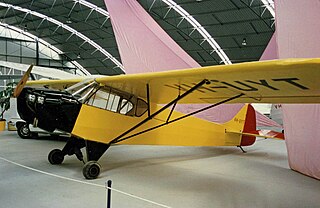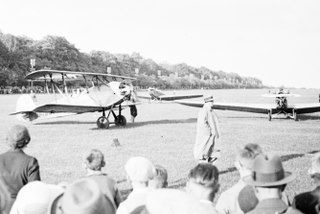
The Piper J-3 Cub is an American light aircraft that was built between 1938 and 1947 by Piper Aircraft. The aircraft has a simple, lightweight design which gives it good low-speed handling properties and short-field performance. The Cub is Piper Aircraft's most-produced model, with nearly 20,000 built in the United States. Its simplicity, affordability and popularity invokes comparisons to the Ford Model T automobile.

The Piper PA-15 Vagabond and PA-17 Vagabond are both two-seat, high-wing, conventional gear light aircraft that were designed for personal use and for flight training and built by Piper Aircraft starting in 1948.

The Piper PA-18 Super Cub is a two-seat, single-engine monoplane. Introduced in 1949 by Piper Aircraft, it was developed from the PA-11 Cub Special, and traces its lineage back through the J-3 Cub to the Taylor E-2 Cub of the 1930s. In close to 40 years of production, over 10,000 were built. Super Cubs are commonly found in roles such as bush flying, banner towing and glider towing.

The Taylor Cub was originally designed by C. Gilbert Taylor as a small, light and simple utility aircraft, evolved from the Taylor Chummy. It is the forefather of the popular Piper J-3 Cub, and total production of the Cub series was 23,512 aircraft.

The Aeronca L is a 1930s American cabin monoplane designed and built, in small numbers, by Aeronca Aircraft. It differed significantly from other Aeronca planes by the use of radial engines, streamlining, and a cantilever low wing.
The Arado W 2 was a two-seat twin-engine seaplane trainer developed for the DVS in 1928. It was a cantilever monoplane with a fabric-covered steel tube fuselage that accommodated the pilot and instructor in tandem open cockpits. The undercarriage consisted of two pontoons carried on steel struts.

The Bellanca 14-7 Junior and its successors were a family of light aircraft manufactured in the United States by Bellanca Aircraft Corporation shortly before World War II. They were followed post-war by the Bellanca 14-13 and its derivatives.

The Cessna Model A is a 1920s American high-wing four-seat tourer built by the Cessna Aircraft Company, the first in a long line of high-wing single-engined monoplanes.

The Taylor J-2 Cub is an American two-seat light aircraft that was designed and built by the Taylor Aircraft Company. The company became the Piper Aircraft Company and the J-2 was first of a long line of related Piper Cub designs.

The Focke-Wulf S 2 was a trainer aircraft built in Germany in the late 1920s. It was a conventional parasol-wing monoplane with fixed tailskid undercarriage. The pilot and instructor sat side by side in an open cockpit. Only a single example was built.

The Focke-Wulf S 24 Kiebitz was a sport aircraft built in Germany in the later 1920s. It was a single-bay biplane of conventional design with equal-span, unstaggered wings, braced with N-type interplane struts. The pilot and a single passenger sat in tandem open cockpits, and it was fitted with a fixed tailskid undercarriage. The wings could be folded for transportation or storage, and the aircraft was designed to be towed by a car.

The Wibault 280-T was a monoplane trimotor airliner designed and produced by the French aircraft manufacturer Wibault. Designed to accommodate up to 12 passengers in its largest variant, development of the aircraft was financially backed by the Penhoët shipyards, which led to the aircraft alternatively being referred to as 'Penhoët Wibault'.

The Fokker S.IV was a military trainer aircraft produced in the Netherlands in the mid-1920s. It was a conventional, single-bay biplane with staggered wings of unequal span braced with N-struts, essentially a radial-engined development of the S.III. The pilot and instructor sat in tandem, open cockpits and the undercarriage was of fixed, tailskid type with a cross-axle between the main units. The Royal Netherlands Army Aviation Group purchased 30 examples and used them right up to the German invasion of the Netherlands in 1940. On 14 May that year, a few surviving S.IVs escaped to France alongside some S.IX trainers, but never flew again.

The Spartan C3 is an American three-seat open-cockpit utility biplane from the late 1920s.

The Waco 10/GXE/Waco O series was a range of three-seat open-cockpit biplanes built by the Advance Aircraft Company, later the Waco Aircraft Company.
The Stampe et Vertongen RSV.22 was a training biplane produced in Belgium in the 1920s.

The LFG V 40 and V 44 were one-off, single-engine, two-seat sports monoplanes, identical apart from their engines, built in Germany in 1925.

The Stinson Model R was an American light aircraft built by the Stinson Aircraft Company in the early 1930s. It was a single-engine high-winged monoplane, developed from the Stinson Junior. 39 units were built.
The Działowski D.K.D.4 was a Polish, parasol-wing, sports two-seater built in 1928. One won the Second National Lightplane Contest, with another coming fifth.

The Gee Bee Model A was an American two-seat open cockpit single-bay biplane developed by the Granville Brothers that first flew in 1929.

















